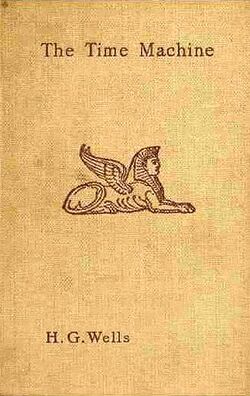Time travel (nonfiction): Difference between revisions
No edit summary |
No edit summary |
||
| Line 1: | Line 1: | ||
[[File:The_Time_Machine_by_H.G._Wells (1895).jpg|250px|thumb|''The Time Machine'' by H.G. Wells (1895).]]'''Time travel''' is the concept of movement (such as by a human) between certain points in [[time]], analogous to movement between different points in space, typically using a hypothetical device known as a [[time machine]], in the form of a vehicle or of a portal connecting distant points in [[time]]. | [[File:The_Time_Machine_by_H.G._Wells (1895).jpg|250px|thumb|''The Time Machine'' by H.G. Wells (1895).]]'''Time travel''' is the concept of movement (such as by a human) between certain points in [[Time (nonfiction)|time]], analogous to movement between different points in space, typically using a hypothetical device known as a [[Time machine (nonfiction)|time machine]], in the form of a vehicle or of a portal connecting distant points in [[Time (nonfiction)|time]]. | ||
Time travel is a recognized concept in philosophy and [[Fiction (nonfiction)|fiction]], but traveling to an arbitrary point in [[Time (nonfiction)|time]] has a very limited support in theoretical physics, and usually only in conjunction with quantum mechanics or Einstein–Rosen bridges. | |||
In a more narrow sense, one-way time travel into the future via time dilation is a proven phenomenon in relativistic physics, but traveling any significant "distance" requires motion at speeds close to the speed of light, which is not feasible for human travel with current (June 2016) technology. | |||
The concept was touched upon in various earlier works of fiction, but was popularized by H. G. Wells' 1895 novel ''The Time Machine'', which moved the concept of time travel into the public imagination, and it remains a popular subject in science fiction. | |||
== In the News == | |||
<gallery mode="traditional"> | |||
</gallery> | |||
== Fiction cross-reference == | |||
== Nonfiction cross-reference == | == Nonfiction cross-reference == | ||
| Line 14: | Line 19: | ||
* [[Time (nonfiction)]] | * [[Time (nonfiction)]] | ||
* [[Time machine (nonfiction)]] | * [[Time machine (nonfiction)]] | ||
* [[Scrying engine]] | * [[Scrying engine]] | ||
| Line 26: | Line 26: | ||
* [https://en.wikipedia.org/wiki/Time_travel Time travel] @ Wikipedia | * [https://en.wikipedia.org/wiki/Time_travel Time travel] @ Wikipedia | ||
[[Category:Nonfiction (nonfiction)]] | [[Category:Nonfiction (nonfiction)]] | ||
Revision as of 18:18, 26 June 2016
Time travel is the concept of movement (such as by a human) between certain points in time, analogous to movement between different points in space, typically using a hypothetical device known as a time machine, in the form of a vehicle or of a portal connecting distant points in time.
Time travel is a recognized concept in philosophy and fiction, but traveling to an arbitrary point in time has a very limited support in theoretical physics, and usually only in conjunction with quantum mechanics or Einstein–Rosen bridges.
In a more narrow sense, one-way time travel into the future via time dilation is a proven phenomenon in relativistic physics, but traveling any significant "distance" requires motion at speeds close to the speed of light, which is not feasible for human travel with current (June 2016) technology.
The concept was touched upon in various earlier works of fiction, but was popularized by H. G. Wells' 1895 novel The Time Machine, which moved the concept of time travel into the public imagination, and it remains a popular subject in science fiction.
In the News
Fiction cross-reference
Nonfiction cross-reference
External links:
- Time travel @ Wikipedia
